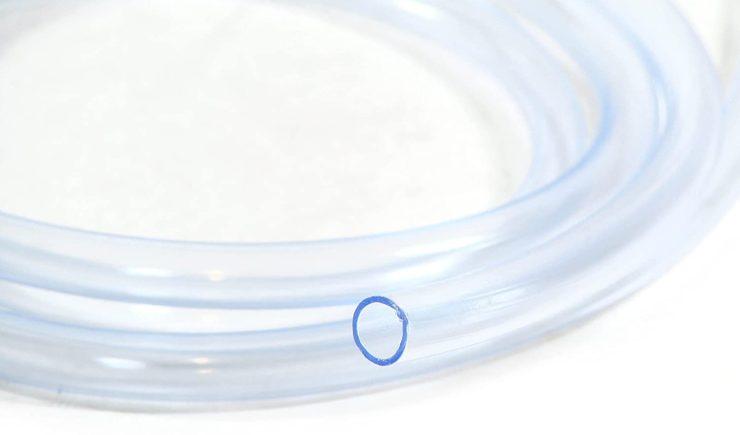Cleanliness is the most important aspect of brewing beer, even above the ingredients or your high-priced equipment.
Buckets and fermentors are usually pretty straightforward to clean. The fact that you can get your hand in them, means that you can safely clean out all the brewing residue before stashing it away for next time.
However, there is one super important part of your brewing setup that cannot be cleaned by hand – your hoses. Hoses are commonly used in kegerators, siphons and to transfer wort or beer from one place to another. Whether your hoses are made of silicon, PVC or something else, these pesky things can present a challenge for new homebrewers and experts alike.
So what are the best ways to clean your hoses?

Clean vs. Sanitize
Keep in mind that that “clean” doesn’t necessarily mean “sanitized”. Cleaning your hoses simply removes any gunk or beer residue from the hoses. However, cleaned does not equal sanitized. Microscopic bacteria can still be inside your hoses even after a good cleaning. To sanitize, you need to use a solution like Star San. StarSan, an awesome and prettry standard product for home brewers, takes anywhere from 30 seconds to 3 minutes to work its way into the microscopic cracks and crevices that can harbor bacteria.

Is it Time to Replace Them?
Depending on how frequently you brew, your hoses may be at the end of their usefulness. At least every year, I just buy a new roll of tubing and replace everything I can. No matter how well you clean your hoses, they will eventually begin to stain and lose their pliability. Old hoses begin to dry rot and will usually begin to keep their kinks and folds well after unfurling them. A giveaway clue is when they seem to be getting stiffer. If you notice this, it’s time to replace the hoses.
No Scrubbing!!!
Plastic in particular, such as those Ale Pails so many of us have, gets scratched easily with abrasive scrub brushes or pads. Those small etches make perfect little habitats for bacteria to grow in. You may not be able to see these scratches with your naked eye. Glass and metal will not, so your steel fermentors and glass carboys are safe to be vigorously scrubbed. However, plastic buckets and tubing will need an alternate way of being cleaned.
Clean Them Immediately!
Clean all your equipment immediately after use – not just the hoses. I clean the areas where things like wort will dry the quickest and I clean them first. Otherwise they get sticky and messy very quickly and its harder to clean next time.
If you clean your hoses immediately after using them, usually hot water is all you’ll need. Hot water will remove any residue that is left inside the hose. I prepare to clean equipment while the wort is transferring to fermentors by preparing a 3-4 gallons of boiling water in the hot liquor tank. WHen its done transferring, I start pumping the water to the mash tun and then the boiling kettle for 2-3 minutes at a time, waiting 2-3 minutes in between. That allows some hot water soak time. Then continue till its all flushed.
After washing them out, I often squirt a few sprays of StarSan into one end of the hose as well. If I have a bucket of Star San, I’ll dunk them too. However, be careful doing this. Don’t leave them sitting inside the bucket for too long, say 1-3 minutes. The plastic in the hose can start to break down when left in contact with Star San for too long, and it’ll need to be thrown away – you’ll know because they will start turning opaque white.
PBW Wash

PBW is an alkaline, non-caustic, environmentally and user-friendly cleaner that every brewer should have in their arsenal. PBW (Powder Brewery Wash) a brand name cleaner that is made by Five Star Chemicals. Again this is pretty much a standard all homebrewers use.
Whether you use PBW or a sodium precarbonate wash, make up about 2.5 gallons and let your hoses soak in it for 10-15 minutes, then flush/wash with warm water.
Boil Your Silicone
Did you know that you can boil silicone hose to sanitize and clean them? Thats the beauty of Silicone! Silicone can withstand temperatures way above that of which water boils (212F), so there is no harm in destroying them.

My Typical Procedure When Cleaning Hoses
After all that, this is my typical procedure for cleaning my hoses. This process works with any food-grade hose, used for any purpose (coffee, keg or soda lines, etc).
- Before use, spray or submerge in Star San for 3-5 minutes.
- Immediately after use, run warm, clean water through the hose.
- Set them in a bucket of PBW for 10-15 minutes. There is no need to rinse them after removing from the bucket.
- Spray Star San inside the hoses, and let them air dry.
- Hang up for next time.
For pipes or hoses that cannot easily be submerged, like siphons or keg dip tubes, consider laying them down on a cookie sheet or kiddie pool thats filled with PBW or Star San.
Lets Not Forget About Fittings!
This is an often overlooked area of sanitization that has sure bit me a time or two!
Stainless steel fittings are pretty much impervious to infection if properly sanitized. However it is possible for your fittings, gaskets, valves, pumps, and tubes to harbor bacteria in the joints, cracks and casting bubbles. Always disassemble your kegs, siphons, fittings and valves before each brew and properly sanitize them. Don’t ever assume that just because it’s hard to remove or clean that bacteria won’t be in there. This is one of the reasons I am converting slowly over to triclamp connections – because they are so easy to disassemble and clean (as well as quickly put together a set of fittings/connectors I might need at the time).

Lance Lillie
